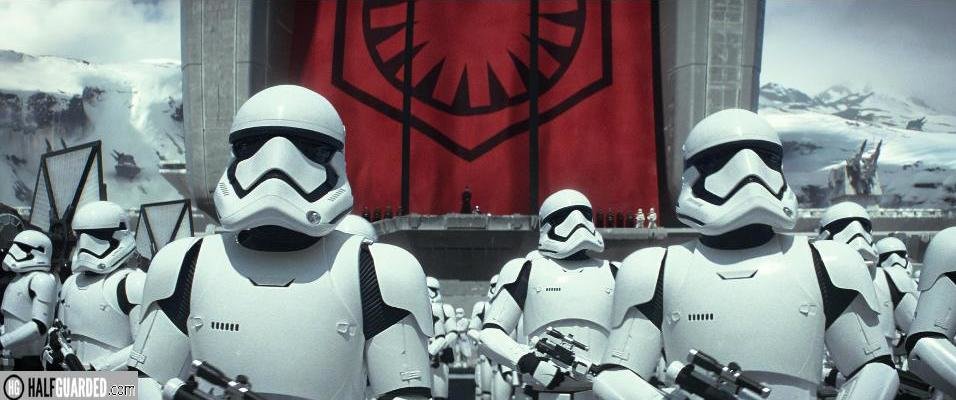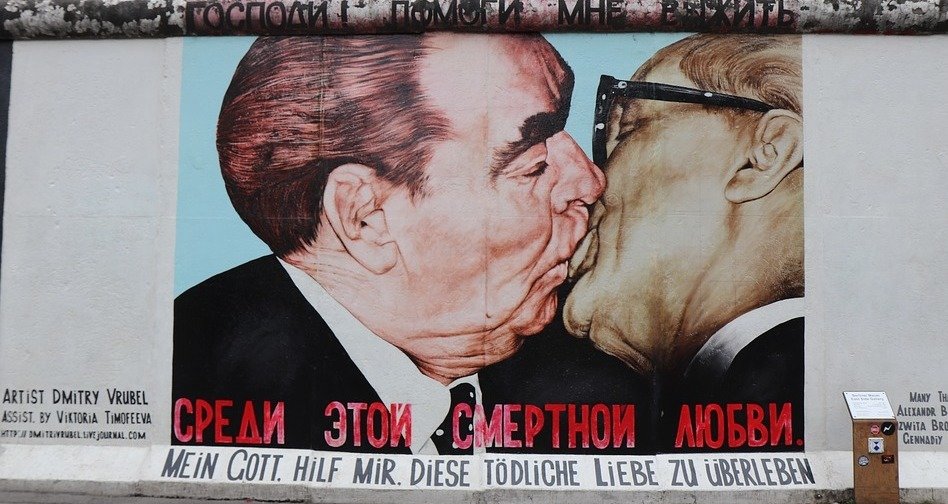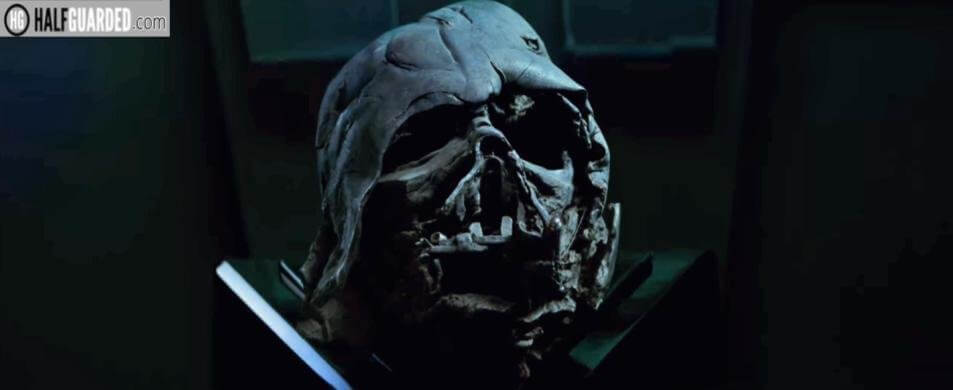My abiding memories of my cinema going experience of 1994 were repeatedly travelling to multiplex in Stoke to see Pulp Fiction, while at the same time looking out for late night special showings of Reservoir Dogs. You see film fans in the UK were suffering through a media backlash against violent movies, spurred on by the kidnapping and murder of a two year old by two ten year old boys. The shocking crime needed a explanation and so the public ate up the scapegoat of violent films, when a VHS of Child’s Play 3 (which there was no proof the boys had seen) was seen at the home of one of the boys.
As newspapers fuelled a public outcry, Reservoir Dogs was for a long time denied a home video release and the written by Tarantino film Natural Born Killers was even banned from cinemas altogether. Admittedly heavy and disturbing films like Henry:Potrait of a Serial Killer and Man Bites Dog were paraded as dangerous films by the great and good, while even blockbusters such as Silence of the Lambs and Falling Down were suddenly been decried.
As a lot of films of a violent nature were also proving to be amongst the most creative and groundbreaking, it was perhaps a challenging time to be a film lover. I myself felt I was defending my interest in films, especially as I was going through a heavy horror phase.
Despite this, 1994 had a wealth of awesome movies, both exciting blockbusters and worthy smaller films and it was quite the task to choose just three movies (and one WTF? moment) that made a lasting impression on me as a film goer.
Ed Wood (directed by Tim Burton)
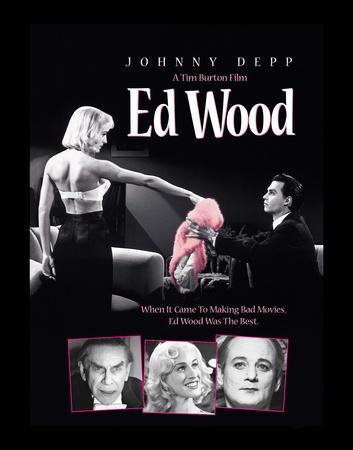
Johnny Depp stars in a biopic of the “Worst Director of All Time” Ed Wood. Helped by an ageing Bela Lugosi and an assortment of oddball characters, Wood Strives for Hollywood stardom but instead creates infamously awful movies.
Around 1989, the UK television Channel 4 had found an alternative audience for itself catering to fans of weird and cult movies. One night I settled in to watch what Channel 4 was billing as “The Worst film of all time,” the 1956 sci-fi film Plan Nine from Outer Space. If this had been a deliberate spoof it could not have been better. I was amazed that this was a serious attempt at a movie with such awful acting, cheesy dialogue, beyond cheap special effects, obviously thrown together sets and an hilarious chase through a graveyard where the cardboard tombstones kept falling over (and incredibly had been left in the final edit).
But the “Worst movie of all time?” I baulked at this. I’d seen far worse and frankly unwatchable movies in my years as a video rental store addict. Unlike a lot of badly shot films I have seen in my time, one of the things that Plan Nine had going for it was a really clean aesthetic that makes the film easy on the eyeballs.
There was also a naive charm surrounding the film, as if there was real passionate effort into making this film good and actually thinking it had succeeded in doing so. This was the perfect vibe that would be recreated five years later when Ed Wood hit our screens, bringing to life the story of the by then cult famous director.

Considering the darkness of the true life source material (Ed Wood died, alcoholic and broke at 57 before his films would have a new audience) Ed Wood is surprisingly hilarious and even upliftingly touching. Director Tim Burton strikes the right balance of poking fun at Wood and the delusions over this talent but without malice and imbuing him with a unflappable, upbeat spirit. His positive take on every setback while filming is infectious, making you root for him because you buy into his creativity and passion as misguided as it is. His good nature and charisma make you side with him against the level headed detractors who are actually talking sense when they tell him he is making horrible movies.
“You Know Hon, when you rewrite a script it just gets better and better”
Ed Wood is a film that delights movie lovers, especially those interested in the fast paced guerrilla style of low budget 50’s movies. Early on Wood goes for a job as director for a movie and asks if there is script, to which the producer replies “Fuck no, but we got a poster,” and then adds “we open in eight weeks.”
The sleazy producer is just one of the many colourful characters portrayed by an amazing cast that incredibly mirrors the eccentric followers of Ed that appeared in his movies. Bill Murray, Jessica Sarah Parker (years before sex and the city and absolutely dripping with pissed off venom as Ed’s long suffering girlfriend), Particia Aquette, George “the Animal” Steele (perfect as the monstrous figure Tor Johnson a staple of Ed Wood films) but stealing the film is Martin Landau in his Oscar winning performance as Bela Lugosi. The ageing star is a tragic, washed up figure, addicted to drugs and forgotten by Hollywood and the public that assumes him to be dead. His relationship with Wood is touching, with Ed trying to give the broken down star one last run. In his final scene, Lugosi is more alive than he’s been throughout the film, cheering up a downbeat Wood with a resounding monologue drawing on his past glories as if he feels young again.
Ed Wood is a gloriously fun film, and shot in black and white it captures a 50’s movie style feel. The dialogue is sharp and funny and typical of Burton and Depp at their creative best is daring and original. Naturally audiences didn’t get it and the film was a massive bomb. But Ed Wood would be in my top 100 films (if I ever did that list), a wonderful homage and while it’s not essential to enjoying it, seeing Plan Nine from Outer Space will really make you appreciate how great the reconstruction of that movie is done.
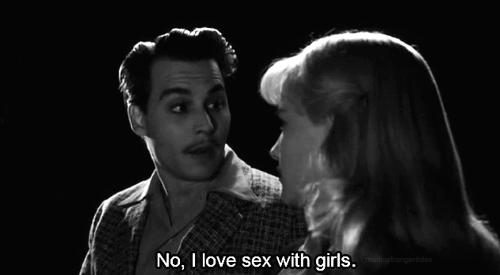
Wyatt Earp (directed by Lawrence Kasdan)

The life of Wyatt Earp as portrayed by Kevin Costner. From his youth exploring the wild west, to his days as law enforcer in Dodge City and Tombstone. Culminating with his feud with the Clantons and the infamous Gunfight at the OK Corrall.
If you’re reading this I really hope that you hold at least one movie opinion that flies against popular accepted movie taste. The sort of belief you have on a film that when you share makes people stare at you in wide eyed disbelief and scream at you “are you fucking kidding me?”
I’ve got many of them (I’ll go to the grave never apologising for my love of Suicide Squad and BVS the Ultimate cut), but one that really seems to rankle people, that has been none to freeze faces into a visage of incredulousness is when I admit that when it comes to films about the Gunfight at the OK Corrall I much prefer the Kevin Costner film Wyatt Earp to Tombstone.
Now once you’ve cleaned off any food you’ve spat all over whatever device you’re reading this on, let me explain I actually like Tombstone. I think it’s a fun action western, a great popcorn flick that put’s some old school colour into a modern western. And there are some elements that I think beat Wyatt Earp hands down, such as the casting of Sam Elliott and Bill Paxton as the Earp brothers. I also admit that Michael Biehn as Johnny Ringo and Powers Boothe as Curley Bill are exceptional and beat the hell out of any actors from the villains side in Wyatt Earp.
Yet all that said I prefer the sprawling epic of the life of Wyatt Earp that is the Costner version.

When I saw it at the cinema, I absolutely loved the film. I didn’t feel the three hour running time one bit, I was so engrossed in Wyatt’s journey through life, his attempts to make a life for himself in the Wild West through various careers, when it was clear the one thing he excelled at was as a lawman. It didn’t matter to me that this Earp was a moody, sometimes unsympathetic character, because this fitted in with what I’d read about the real life figure.
I thought the film looked absolutely beautiful, expressing the vastness of the American frontier and the dusty grit of the burgeoning towns (the film was nominated for Best Cinematography at the Oscars). I was swept away by the score, which evoked a legendary aura to the film. But it was in the build to the famous Ok Corrall gunfight that the music really came into play, the dramatic foreboding tone rising to a exhilarating march towards destiny as the Earp’s and Doc Holiday squared up against the Clantons.
What I loved most about the film, and will no doubt lead to my most contentious take when comparing to Tombstone, was Dennis Quaid’s performance as Doc Holiday. Quaid was scarily convincing as the diseased withered Holliday, filled with rage and pus, but with unwavering loyalty to his friend Wyatt and dare I say it, I thought superior to Val Kilmer’s much loved interpretation of the role. I even think Quaid was worthy of consideration of an Oscar nomination that year, so intense was he in the role.
I adored the film, bought it on VHS at a time when I wasn’t really buying tapes and recommended it to anyone who would listen. Yet it became clear I was alone in my love of Wyatt Earp. Friends who took me up on my recommendation told me they hated the film. A showing with some friends at College didn’t go well as they all admitted they were bored and asked if we could watch something else (really annoying considering the amount of shit I had patiently endured many times before). And this was a general consensus, as critics and audiences alike hated the film and was nominated across the board for the Razzies that year, including worst film and actually winning worst actor for Costner (although the Razzies have always had it in for anything Costner related).
In the battle of the OK Corrall movies of 94, Tombstone destroyed Wyatt Earp at the box office, critically and in viewer’s hearts. Tombstone is considered a cult classic to this day, while Wyatt Earp is mostly forgotten and with it’s bad reputation and three hour run time is hardly likely to ever gain any new appreciators.
Despite this derision and the incredulous looks that I receive when I admit this, I still love Wyatt Earp to this day. I admire it’s ambition and I think it looks and sounds like an epic saga. I realise I may be in a minority of one here, but as a film fan the only opinion that should ever really count is our own.

The Crow (Directed by Alex Proyas)

On the anniversary of his own murder and that of his fiancee, Eric Draven rises from the Grave and embarks on a violent crusade to wipe out the gang members responsible.
It’s hard not to watch The Crow and not have your viewing effected on some level, by knowing that charismatic lead actor Brandon Lee died while filming a scene in it, (Lee was killed when shot with a prop gun that wasn’t emptied properly). The film already has a melancholy sense of tragedy with a the slaughter of young, loving and well liked couple (we only get to know them in the briefest of flashbacks and the memories of a streetkid and cop who liked and missed them). That sense of loss in the story is amplified by the spectre of the real loss of Brandon, especially in the final moments where he returns to his grave and is reunited with the vision of his loved one Shelley. It really makes these scenes more poignant and heartbreaking, as does the number of times a tender scene ends in a freeze frame.
That the scene where Brandon was shot is also the moment that the character Eric Draven dies (contrary to early myths the scene was remade with a stunt double and the initial footage of Brandon being shot was destroyed) is a spooky thought, lending to the idea of a Bruce Lee family curse.
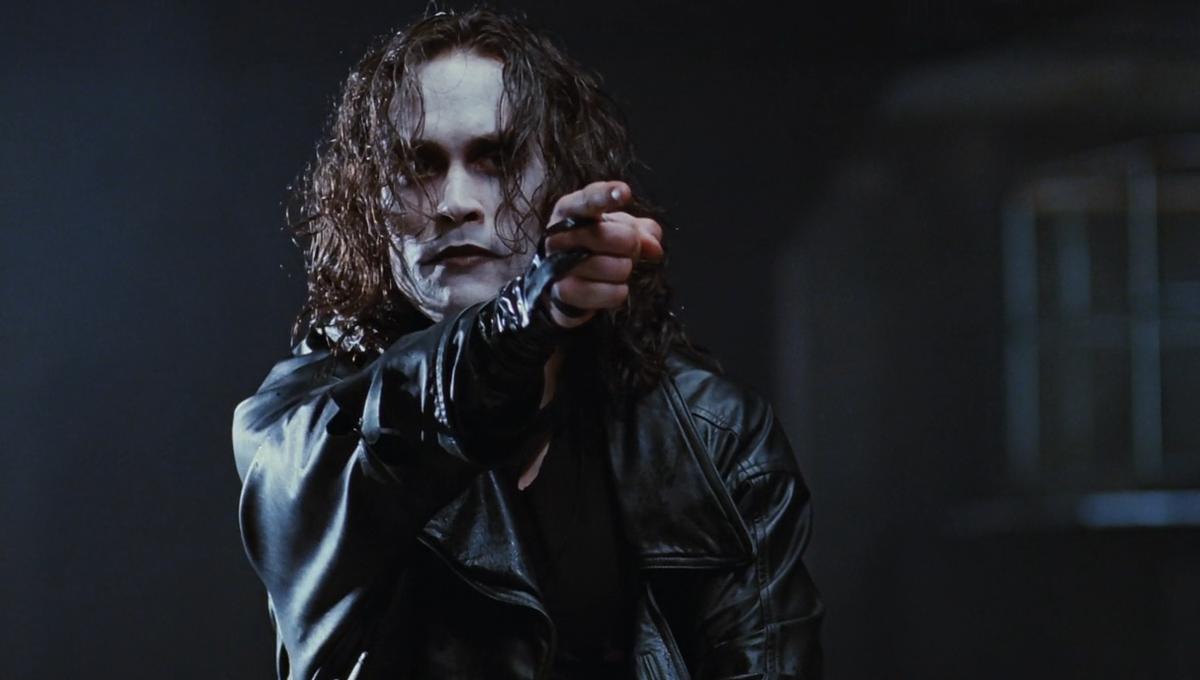
Whether The Crow would have been Brandon Lee’s breakout role we will never truly know (the marketing push for the film and interest is said to have been driven by the notoriety of Brandon’s death, the tone of the film was also said to have been altered significantly in the post production, an influence of the tragedy), but the film we are left with left a lasting impression as one of the wildest movies I saw around at that time.
American action movies in the 90’s had adopted a bland, glossy look, but the Crow had a dirty, gloomy, gothic, loud vibe (perhaps influenced by the grunge music scene). The Crow felt violently rebellious, an adrenaline binge of a ride and a incredibly satisfying revenge movie, as Draven tracks down and slaughters his murderers, subjecting each to imaginative demises. All the while a pulse rising soundtrack Much has been made of the similarities to another well known black clad, scourge of the Underworld, indeed the Detroit in the Crow resembles Gothan City, albeit even darker and out of control, terrifyingly ruled by crazed gangs who light up the city in infernos every Devil’s Night (the night before Halloween that was traditionally a night of vandalism and ironically the 1994 night was the worst in Detroit history and prompted action to be taken). The Crow is a more violent figure than Batman and sits somewhere between him and the Joker, as a clownish figure that sometimes is scarily playful and teasing towards his criminal victims.
The Crow is a great comic book come to life. The action scenes are fast and loud, with a insane mix of gunplay (quite a bit of Hong Kong influence with the shooting of two guns at the same time), swords, knifes and martial arts. The villains themselves while one note are wildly colourful, very comic booky and easy to hate and you’re rooting for them to suffer at the hands of Draven. Standing out are leader of the thugs T-Bird (played by David Patrick Kelley of The Warriors fame) and the leader of of criminal activity Top Dollar (gravelly voiced Michael Wincott) in an over the top but delightfully so hammy performance. All the time the relentless moodiness is matched with a riotous soundtrack then even includes a contribution by The Cure with the haunting “Burn” that accompanies Draven’s resurrection and transformation into the Crow (another song from the soundtrack Big Empty by Stone Temple Pilots won the MTV movie award best song).
Some critics were unimpressed with the cliche villains, lack of any real depth in characters and story. But the film made many fans, me amongst them, that revelled in the hard rocking feel and fun dialogue that revelled in and elevated this B-Movie style premise. Re watching today I’m amazed by how well the film has aged (aside from a few dated CGI effects), far better than many other action films of the decade and surprising considering how it embraced the darker trend of youth culture at the time.
Style may be it’s substance but The Crow is an exciting, thrilling and satisfying revenge movie, that has a forgivable sentimental side and a touching tribute to what could have been.

WTF??? The Fantastic Four….that never was.

Sometime just before Christmas in 1995 (I know the rough date because I’d been in a pub earlier discussing whether Shawn Michaels collapsing on WWF Raw was real or not, weird the things you remember), I was snooping through a friend of a friends nerdy memorabilia collection. One video tape caught my attention, am obvious bootleg of some sort with a amateurish sleeve claiming to be a Fantastic Four movie. Looking at it with a “WTF?” expression (this decades before “WTF” was a thing and we used to actually say and write words in full) I was told “Oh that’s the Fantastic Four Film that was never released.”
I was intrigued, but without the internet to immediately look it up on, I had to pick up the story behind it in dribs and drabs over the years in brief mentions in magazine articles and interviews, often with contradictory conclusions. Even today, following an excellent documentary called “Doomed: The Untold Story of Roger Corman’s Fantastic Four,” there is still uncertainty over who knew what and when and whether the film was actually ever intended for release.

What is clear, is that the whole enterprise was an attempt by producer Bernd Eichinger to retain the rights to making a Fantastic Four movie that he had acquired back in 1983. Unable to get the film into production in the scale he envisioned and with the rights about to expire at the end of 1992, Eichinger teamed up with cult cheapie king Roger Corman to get a low budget FF film into production quickly and in doing so keep the rights for a big budget version down the line.
The commonly accepted story now (thanks especially to a Stan Lee interview) is that the film was made with no intention of ever being released and once the contractual obligations had been fulfilled the film was shelved. This never quite added up as the full story to me, as if this was the case why was time and effort spent on marketing the film and announcing a date and venue for a premier. Certainly the cast who were doing a convention tour (armed with a trailer featuring the music from the Corman classic Battle Beyond the Stars) thought the film was to be released and the director Oley Sassone was putting in time editing the film while working on other films to get the FF completed. Money was also spent to produce an original score, often the final part in any movie production.
I was always suspicious of the “never for release” narrative, as once the film was made, why not release it in some capacity and recoup some money? This was the era of Blockbuster, where straight to video rentals were still a viable money maker.
While opinions are still divided amongst those interviewed for the “Doomed” documentary, a clearer picture seems to emerge. Maybe in keeping with the plan of Eichinger all along (he always insisted the contract stipulated he had to release the film), Marvel stepped in and fearing that a poor Fantastic Four film would hurt the value of their other properties they were trying to sell at the time. They offered to buy the film from him and Corman, while allowing him an extension on the rights and they themselves buried the film. According to then Marvel Executive Avi Arad after taken ownership of all the footage it was destroyed (a claim that some on the documentary scoffed at, believing instead that the reels are more likely stored in a vault at Disney somewhere, in between prints of Songs of the South and the Nazi Donald Duck cartoon).
So whether the film was hidden away or destroyed by Marvel, how did a copy end up in a nerd’s video collection just a couple of years later in December 1995. Despite the best efforts of Marvel’s heavy mob, bootleg copies of the film suddenly began appearing on tables at comic book conventions. The production teams and cast were surprised and delighted to discover that the film they had worked on was at least being seen by fans and because of it’s underground (and illegal) distribution was gaining a cult following. Dedicated fans have even produced cleaned up copies on DVD. But where did the original print come from?
In the documentary, director Olly Sassone lends a possible explanation. Before the film was seized he had the opportunity to take a print to a video dubbing business and get a couple of copies made for himself. His suspicion is that someone there made themselves a copy and it leaked from there. The romantic in me would like to think that a worker at Marvel being ordered by Avi Arand to “burn it,” went “fuck you” and instead smuggled the footage out of building and got it out there.
Today, the entire film can be seen on Youtube. It’s really everything you’d expect from a Roger Corman film, very cheap in every department, with awful special effects. However the story behind the 1994 Fantastic Four is far more fascinating than any of the FF movies that managed to actually make it onto the big screen. There is an undeniable curiosity in the film that we were never meant to see, and charm in the story that fans managed to get it out there and save it from oblivion (one of my favourite moments in the documentary is the glee of the cast and crew relating how they discovered people were seeing the film).
Because movies find a way.

Til next time
Dazza



